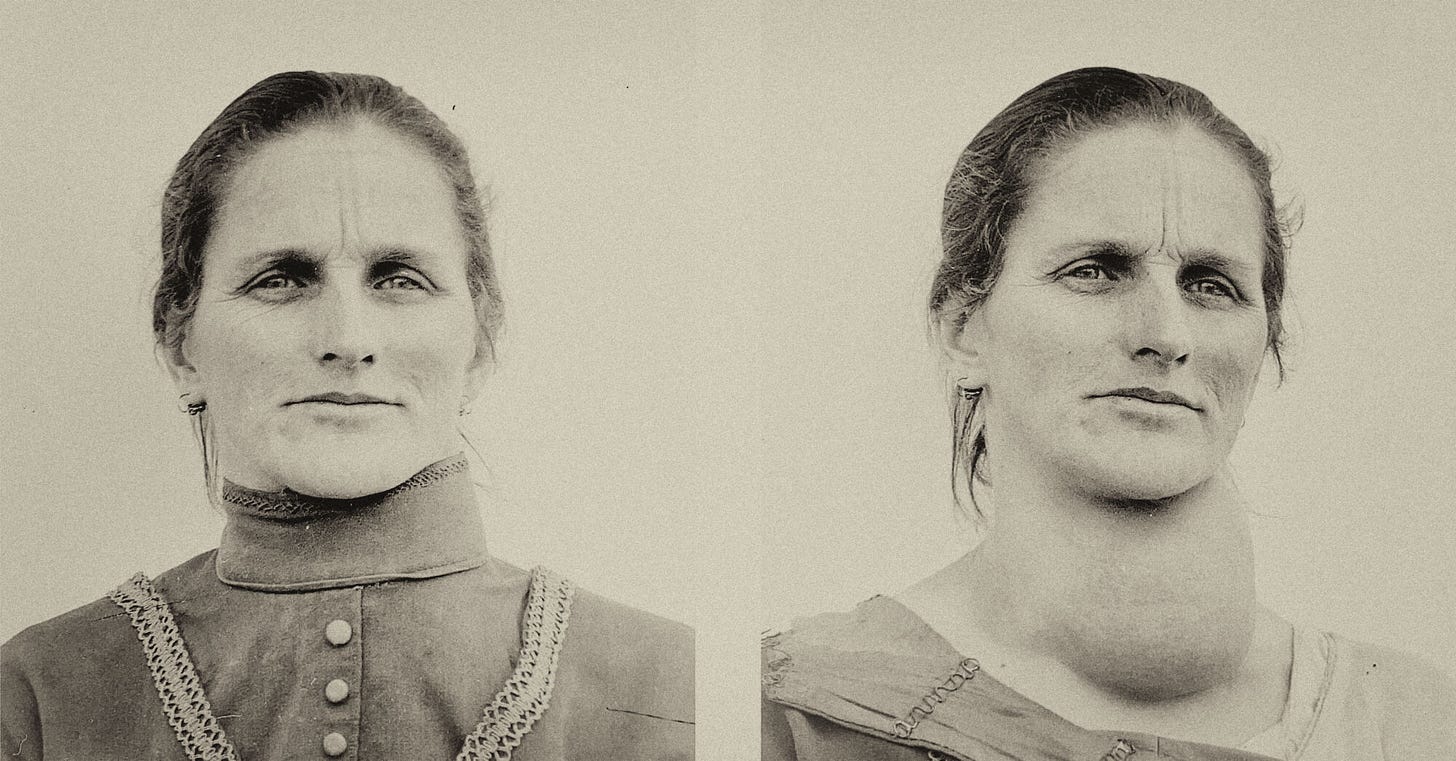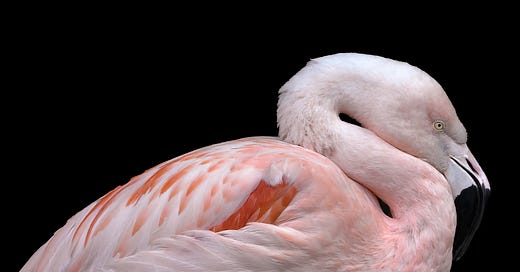From the Andes to the Alps
An appreciation of flamingoes, a personal history with violence, and introducing a new feature: What's Barbara Thinking?
BIRDS
Captive beauty
I’VE RARELY taken pictures of animals in captivity. Yet a group of Chilean Flamingoes that I photographed at the zoo in Seattle has stuck with me. I detect a pathos in the birds’ poses, a singular beauty in their perfectly arrayed pink feathers. They struck me as unique and alive. But it’s common to view captive animals as inauthentic. They’re not wild, which begs the question of what is truly wild, given our ubiquitous impacts on the earth. The snow geese allotted fallow farmland for the winter by the state? The migrating birds at your feeder? I’ve photographed rare honeycreepers in Hawaii—a thrilling experience—but even those birds are captives of a sort. Their habitat is now restricted to the colder highlands as a result of the avian malaria carried by mosquitoes, which arrived in the holds of ships and thrive at the lower elevations.
I enjoy being alone in the woods or on the shore with birds. I become a hunter, in a state of meditative alertness. And I have the luxury of living on the Olympic Peninsula, surrounded by the sea. I understand the appeal of birding as an extreme sport, of seeking ever more rare species in ever more difficult places. Yet even rarity is relative. Among bird photographers, you often see the same “rare” birds on Instagram, such as Costa Rican hummingbirds or ptarmagins on the northern tundra. Here in western Washington, locals will flock to see a couple of visiting meadowlarks. In Kansas, where I lived as a teenager, they were as plentiful as pigeons in New York.
Mostly, I try to stay curious toward the abundant birdlife around me, including the common ones. A local crow is the subject of one of my more successful pictures. I actually think pigeons are gorgeous birds. And while I’d love to photograph a Chilean Flamingo on the Andean Altiplano, I try not to think any less of a Chilean Flamingo that lives in a nearby zoo.
WHAT’S BARBARA THINKING?
A cretinous mystery

Editor’s note: We’re introducing a new feature by Barbara Ramsey, whose wild myriad of interests runs from linguistics to fiber art to R&B music. Science and medicine (she’s a retired physician) make an appearance, too, as this week’s post demonstrates. Next issue: Barbara’s annotated list of her favorite fiction of all time—and an invitation to compile your own.
I just read an essay that has it all: history, politics, geology, Mark Twain, and a Nazi doctor. What could possibly bring these threads together? Goiters in Switzerland!
In an article in London Review of Books, British journalist Jonah Goodman uncovers the nearly forgotten story of a 20th century medical miracle. You may think you don’t care about thyroid disease or cretinous children or the governance of Swiss cantons, but I promise that Mr. Goodman will have you glued to the page.
While concluding with a victory of truth over ignorance, the essay also illustrates the meaninglessness of the “trust science” meme. Whose science? Which data? What doctor? Scientific inquiry can be a blood sport, baby. Medical progress depends on the actions of flawed humans and is easily disrupted (anti-vaxxers come to mind). But Goodman’s story reveals both the noble and ignoble in science—and has a happy ending.
PERSONAL HISTORY
Violence on the left

EARLY ONE MORNING in November 1973 I was eating homemade granola in the kitchen of a north Oakland home that I shared with four roommates. The house was owned by a publishing collective where I worked for a small stipend. I had graduated from a conservative Baptist college in the midwest just months earlier and was thrilled to be surrounded by more simpatico people and exposed to everything from feminism to French-press coffee.
That morning, a clearly distraught roommate came into the kitchen. “They killed my boss,” she said. Pam worked in the district office of Oakland public schools. The night before, a group known as the Symbionese Liberation Army—a name soon on the lips of everyone in the Bay Area—shot Marcus Foster to death in the district parking lot with a sawed-off shotgun loaded with cyanide-laced bullets. Foster was the first black superintendent in Oakland, executed for proposing that students be issued identity badges.
The following summer, in 1974, our publishing collective was invited to set up a booth at a fair sponsored by leftist groups. The event was held at a park named after the suffragette leader, Frances Willard, that the sponsors had re-dubbed Ho Chi Minh Park, after the Vietnamese Communist leader. The featured speaker was Wilbur “Popeye” Jackson, who had been key to negotiations with the SLA after they kidnapped heiress Patti Hearst from her Berkeley apartment. Popeye was president of the United Prisoners Union, which was inspired by George Jackson, a Black Panther Party member and leftwing folk hero. George Jackson was shot to death in the San Quentin yard during an escape attempt in which two hostages and three guards were also killed. A year earlier, his seventeen-year-old brother Jonathan had died while kidnapping a judge at the Marin County courthouse in an attempt to free his older brother. The judge and two others were also killed. Jonathan’s guns were owned by Angela Davis, who was nonetheless acquitted of involvement in the incident. Davis is now a professor at UC Santa Cruz and a prominent proponent of abolishing prisons and defunding the police.1
At the fair, Popeye Jackson singled out white radicals and declared that we were all “chicken-shits” if we did not support the SLA. Whoa. After the elation of finding new friends in the Bay Area, I’d suddenly landed in a nightmare. As a teenager, I’d been inspired by Martin Luther King, Jr. and his nonviolent Civil Rights Movement. I opposed the Vietnam War because it involved the senseless killing of Vietnamese civilians and American soldiers. When I was a senior in high school, I was horrified by the killing of protesting students at Kent State in Ohio and Jackson State in Mississippi. Now I was being directed to support murderers of a black school superintendent.
Even those who might have followed Popeye’s advice never got the chance. After their dramatic rise, the SLA fell quickly. In May, six members were killed in an LA shootout with police in which 9,000 rounds of ammunition were fired. I watched it unfold on live television. A year later, Popeye himself was murdered. He was sitting in a car in the Mission District with Sally Voye, a young Berkeley grad volunteering in a prison reading program, when someone unknown walked up and shot them to death.
THE SAME SUMMER, the Weatherman (née Weather Underground) issued a manifesto entitled Prairie Fire that outlined a program for anti-imperialist revolution. Unbeknownst to me, former members of our collective had arranged for the pamphlet to be collated in our office at night. The Weather Underground, founded by Bill Ayers, Bernandin Dohrn, and others, had taken militant positions within the Students for a Democratic Society that let to its downfall in 1969. By blowing up buildings and other acts of violence they also helped drain popular support for the antiwar movement, which had been founded by pacifists, veterans of the Civil Rights Movement, and free speech advocates. Dohrn later became an associate professor of law at Northwestern University and Ayers, her husband, a professor of education at the University of Illinois in Chicago.

FORTUNATELY I SOON found a new group of friends who shared my democratic values2 and within the year had decamped to Chicago, where I was a founding staff member of In These Times. Editor and historian James Weinstein moved the paper to Chicago to help cement its orientation toward a working-class politics and away from the sectarian cultural upheavals that were prominent in the Bay Area left. During our first few years in Chicago, the Bay Area was repeatedly rocked by violence. The Black Panther’s bookkeeper was found floating in the bay. Liberal mayor Mayor George Moscone and Supervisor Harvey Milk were assassinated. Faye Stender, lawyer to Huey Newton and George Jackson, was shot multiple times in her home by a paroled member of the Black Guerrilla Family, which had been founded by Jackson. Severely crippled, she later committed suicide. Jim Jones, whose People’s Temple had been praised by left politicians for its community outreach and commitment to racial equality, relocated his San Francisco church to Guyana, where he ordered the killing of a congressman and perpetrated a murder/suicide of over 900 of his followers.
These memories flooded back when I recently saw university students and leftists heralding terrorist murderers and rapists as liberators.3 Perhaps I should not have been surprised. Militant leftists of my generation cheered the violence perpetrated by Mao’s cultural revolution, Che Guevara, and Daniel Ortega, among others. Several wound up in university classrooms instructing new generations of radicals.4 We should count ourselves fortunate that their young students seem more interested in assassination by brutal tweets rather than guns.
Davis’s mentor at UC San Diego was Herbert Marcuse, a philosopher from the Marxist Frankfurt School, a progenitor of critical theory. These scholars attacked Enlightenment values that undergird America’s founding ideals of equality and popular sovereignty.
One of those was John Judis, with whom I helped found the East Bay Voice in 1975. John has a new book with Ruy Tuxiera, Where Have All the Democrats Gone? and writes for the Liberal Patriot, which I recommend.
This is not to justify the massacre in Gaza. To get a sense of the scope of the catastrophe, I recommend this interview with the head of the mission for Doctors Without Borders, and this discussion with the former heads of Mossad and Shin Bet, who are critical of the current Israeli government.
For excellent histories of the intellectual roots of critical theory among the professoriate, I recommend Yascha Mounk’s book, The Identity Trap, and philosopher Susan Nieman’s Left Is Not Woke. Mounk edits the excellent Substack Persuasion.








